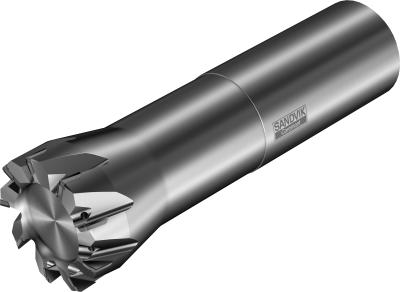
Designed for machining thin-walled aluminum automotive parts without burring, scratching or chipping, the patent-pending M5F90 facemilling cutter is being released by Sandvik Coromant. The two-in-one M5F90 cutter features an design that allows roughing and finishing in a single operation, delivering shorter and more efficient machining strategies.
The M5F90 cutter body diameter (25–80 mm, 0.98–3.15 inch) carries brazed PCD inserts that, thanks to the application of new production processes, need no adjustment and enable high feed rates without vibration. As a result, the potential time and cost savings available to users are considerable. In addition, no scratches, burrs or breakages are produced on the machined part due to a combination of cutting angles, insert shape, edge preparation and cutting parameters.
Notably, roughing and finishing operations are facilitated by a single tool, saving on inventory costs. In terms of roughing, the tool works as a conventional cutter, with all rough-cutting edges positioned on the same diameter and height. The M5F90 is able to machine up to a 4 mm (0.157 inch) DOC. With regards to finishing, this portion of the tool consists of radial and axial stepped cutting edges. Such a configuration ensures burr-free milling and outstanding surface finish on thin-walled aluminum parts, while enabling a close pitch to avoid cutting vibration.
“The inherent flexibility of being able to rough- and finish-mill makes it possible to machine different positions on the same part with just one cutter,” explains Emmanuel David, global automotive product manager at Sandvik Coromant.
“Moreover, the reliable and secure performance of M5F90 delivers superior tool life in comparison to a milling cutter featuring a conventional body. The tool is also environmentally friendly due to its low coolant consumption,” adds Philippe Andre, global automotive application engineer.
Although dedicated to thin-wall milling operations on aluminum parts, such as gearbox casings and housings, the M5F90 is also able to machine large engagement material for applications across the automotive segment.
The M5F90 completes the Sandvik Coromant milling cutter offer for aluminum automotive parts, complementing the M5B90, M5C90, CoroMill Century/590, M5Q90 and M5R90 tooling solutions.
Contact Details
Related Glossary Terms
- coolant
coolant
Fluid that reduces temperature buildup at the tool/workpiece interface during machining. Normally takes the form of a liquid such as soluble or chemical mixtures (semisynthetic, synthetic) but can be pressurized air or other gas. Because of water’s ability to absorb great quantities of heat, it is widely used as a coolant and vehicle for various cutting compounds, with the water-to-compound ratio varying with the machining task. See cutting fluid; semisynthetic cutting fluid; soluble-oil cutting fluid; synthetic cutting fluid.
- edge preparation
edge preparation
Conditioning of the cutting edge, such as a honing or chamfering, to make it stronger and less susceptible to chipping. A chamfer is a bevel on the tool’s cutting edge; the angle is measured from the cutting face downward and generally varies from 25° to 45°. Honing is the process of rounding or blunting the cutting edge with abrasives, either manually or mechanically.
- facemilling
facemilling
Form of milling that produces a flat surface generally at right angles to the rotating axis of a cutter having teeth or inserts both on its periphery and on its end face.
- feed
feed
Rate of change of position of the tool as a whole, relative to the workpiece while cutting.
- gang cutting ( milling)
gang cutting ( milling)
Machining with several cutters mounted on a single arbor, generally for simultaneous cutting.
- milling
milling
Machining operation in which metal or other material is removed by applying power to a rotating cutter. In vertical milling, the cutting tool is mounted vertically on the spindle. In horizontal milling, the cutting tool is mounted horizontally, either directly on the spindle or on an arbor. Horizontal milling is further broken down into conventional milling, where the cutter rotates opposite the direction of feed, or “up” into the workpiece; and climb milling, where the cutter rotates in the direction of feed, or “down” into the workpiece. Milling operations include plane or surface milling, endmilling, facemilling, angle milling, form milling and profiling.
- milling cutter
milling cutter
Loosely, any milling tool. Horizontal cutters take the form of plain milling cutters, plain spiral-tooth cutters, helical cutters, side-milling cutters, staggered-tooth side-milling cutters, facemilling cutters, angular cutters, double-angle cutters, convex and concave form-milling cutters, straddle-sprocket cutters, spur-gear cutters, corner-rounding cutters and slitting saws. Vertical cutters use shank-mounted cutting tools, including endmills, T-slot cutters, Woodruff keyseat cutters and dovetail cutters; these may also be used on horizontal mills. See milling.
- pitch
pitch
1. On a saw blade, the number of teeth per inch. 2. In threading, the number of threads per inch.
- polycrystalline diamond ( PCD)
polycrystalline diamond ( PCD)
Cutting tool material consisting of natural or synthetic diamond crystals bonded together under high pressure at elevated temperatures. PCD is available as a tip brazed to a carbide insert carrier. Used for machining nonferrous alloys and nonmetallic materials at high cutting speeds.

